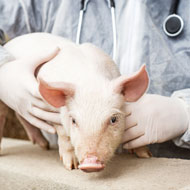
Industry exceeds target two years early
Antibiotic sales for animal use in the UK have fallen to their lowest recorded level, surpassing government targets two years ahead of schedule.
A report released by Defra today (27 October) shows sales of antibiotics for food-producing animals fell by 27 per cent, from 62mg/kg in 2014, to 45mg/kg in 2016. A government target of 50mg/kg was set following recommendations in the O’Neill review last year.
In light of the new report, Defra minister Lord Gardiner praised vets and farmers “for setting an excellent example for others around the world to follow, upholding the UK’s position at the forefront of international efforts to keep antibiotics available for future generations.”
Sales of antibiotics that are considered critically important for human health have also fallen, now accounting for less than 1 per cent of all antibiotics sold for use in animals last year. This includes an 83 per cent reduction in Colistin sales.
The UK’s chief veterinary officer Nigel Gibbens, said the results were “immensely positive” and show the joint efforts of vets and farmers are “paying off”.
He added: “We need solidarity across the profession; no veterinary professional must offer an easy route to access antibiotics where they are not justified.
“Tackling antibiotic resistance requires a commitment across all areas of animal health, together with work on human use by colleagues in the medical professions, and our work together to tackle the issue at global level.”
The UK’s chief medical officer, Professor Dame Sally Davies, said a One Health approach is key to tackling antimicrobial resistance. Calling the findings a “commendable achievement”, she added that we “cannot rest on our laurels”. Instead, we must build on the momentum to do more in every sector and country.
Targets for future reductions in antibiotic use were also announced by RUMA today. The headline targets for reducing antibiotic sales across the sectors by 2020 are: pigs (60 per cent), dairy cattle (20 per cent), game birds (25 per cent this year, and a further 25 per cent between 2018 and 2020) and beef and sheep (10 per cent).
The dairy cattle sector will also aim to halve the use of the highest priority critically important antibiotics. Three sectors - poultry meat, laying hen and fish - will maintain antibiotic use at the minimum level to ensure good health and welfare.



 The RCVS has announced a new version of its 1CPD mobile app, with enhanced features for veterinary surgeons and veterinary nurses to record their continuing professional development.
The RCVS has announced a new version of its 1CPD mobile app, with enhanced features for veterinary surgeons and veterinary nurses to record their continuing professional development.